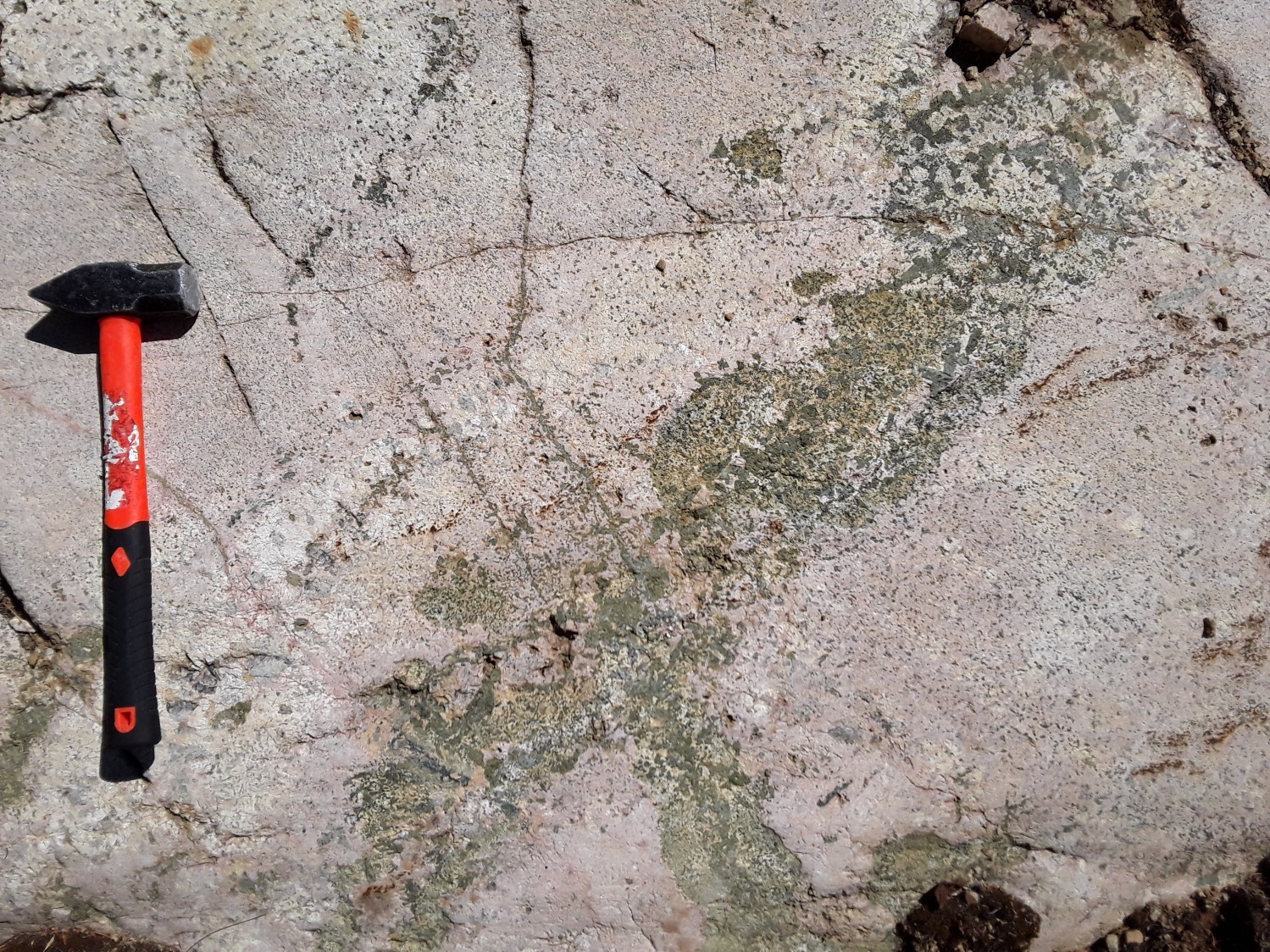
DISCLAIMER: This English version is translated from the original French. In case of any discrepancy, the French version shall prevail.
| Author(s): | Bilodeau, 2022 |
| Age: | Mesoproterozoic |
| Stratotype: | Reference outcrops 2021-CB-1113, 2021-CB-1242 and 2021-CB-1111 |
| Type area: | NE part of Île-du-Grand-Calumet (NTS sheet 31F10) |
| Geological province: | Grenville Province |
| Geological subdivision: | Allochton |
| Lithology: | Intermediate and felsic intrusive rocks |
| Category: | Lithodemic |
| Rank: | Lithodeme |
| Status: | Formal |
| Use: | Active |
None
Background
The Schwartz Intrusive Suite was introduced by Bilodeau (2022) after a geological survey carried out in the Île-du-Grand-Calumet area in 2021.
Description
The Schwartz Intrusive Suite comprises calc-alkaline rocks of intermediate to felsic composition. Two lithological facies have been differentiated on the basis of their K-feldspar amount: a quartz monzonite facies and an alkali feldspar granite facies. These two lithologies are cut by felsic to mafic dykes. The Schwartz Intrusive Suite stands out from other intrusive units in the area because of its higher radiometric signature and lower magnetic susceptibility. Spectrometric data recorded in outcrops with a RS-125 Handheld Spectrometer reveal a thorium-bearing environment. Radiometric counts are generally high compared to the surrounding background and include some values superior to 1000 counts per second (c/s), with a punctual maximum of 11,000 c/s (e.g. outcrop 2021-CB-1111).
Quartz Monzonite
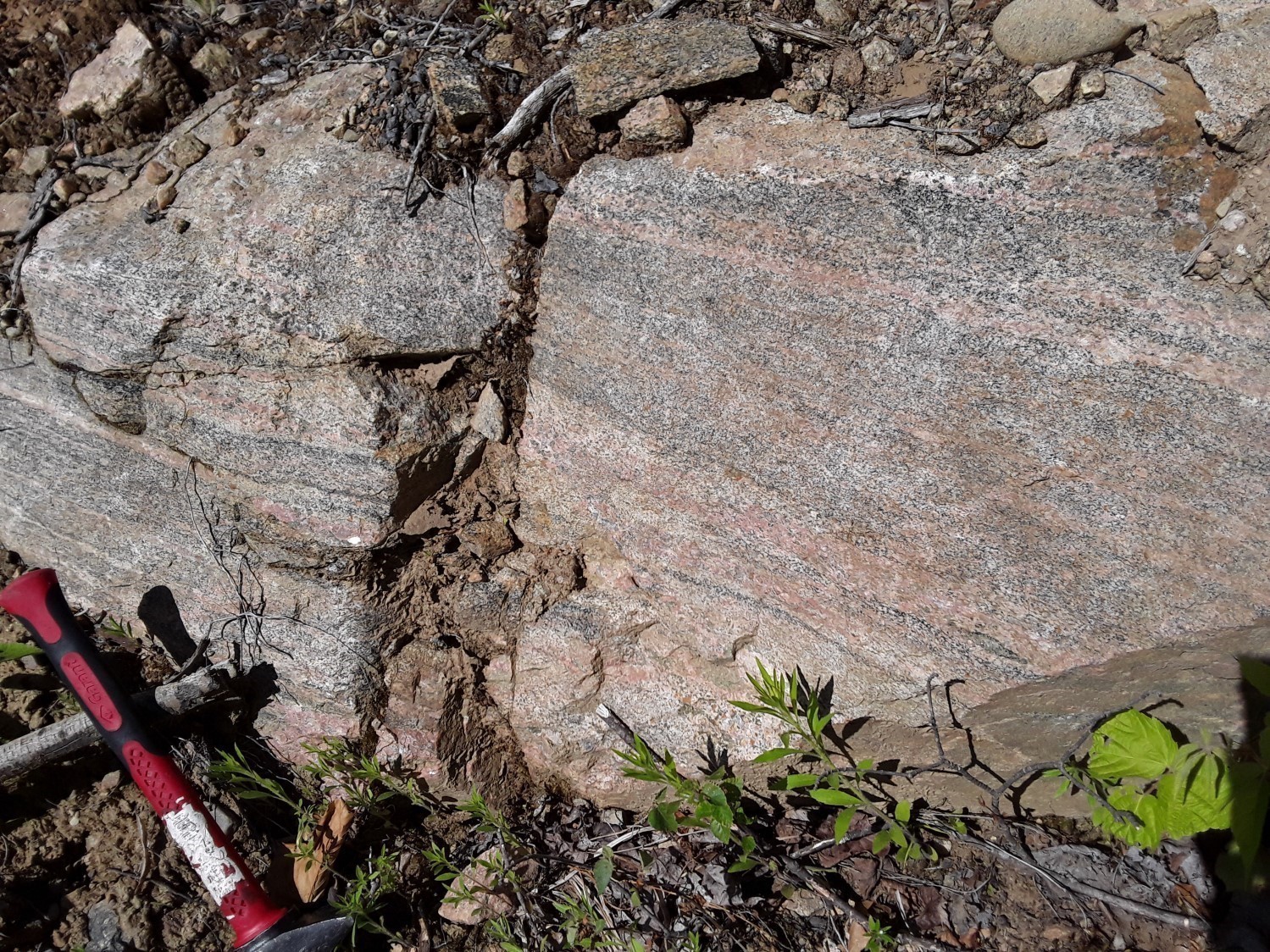
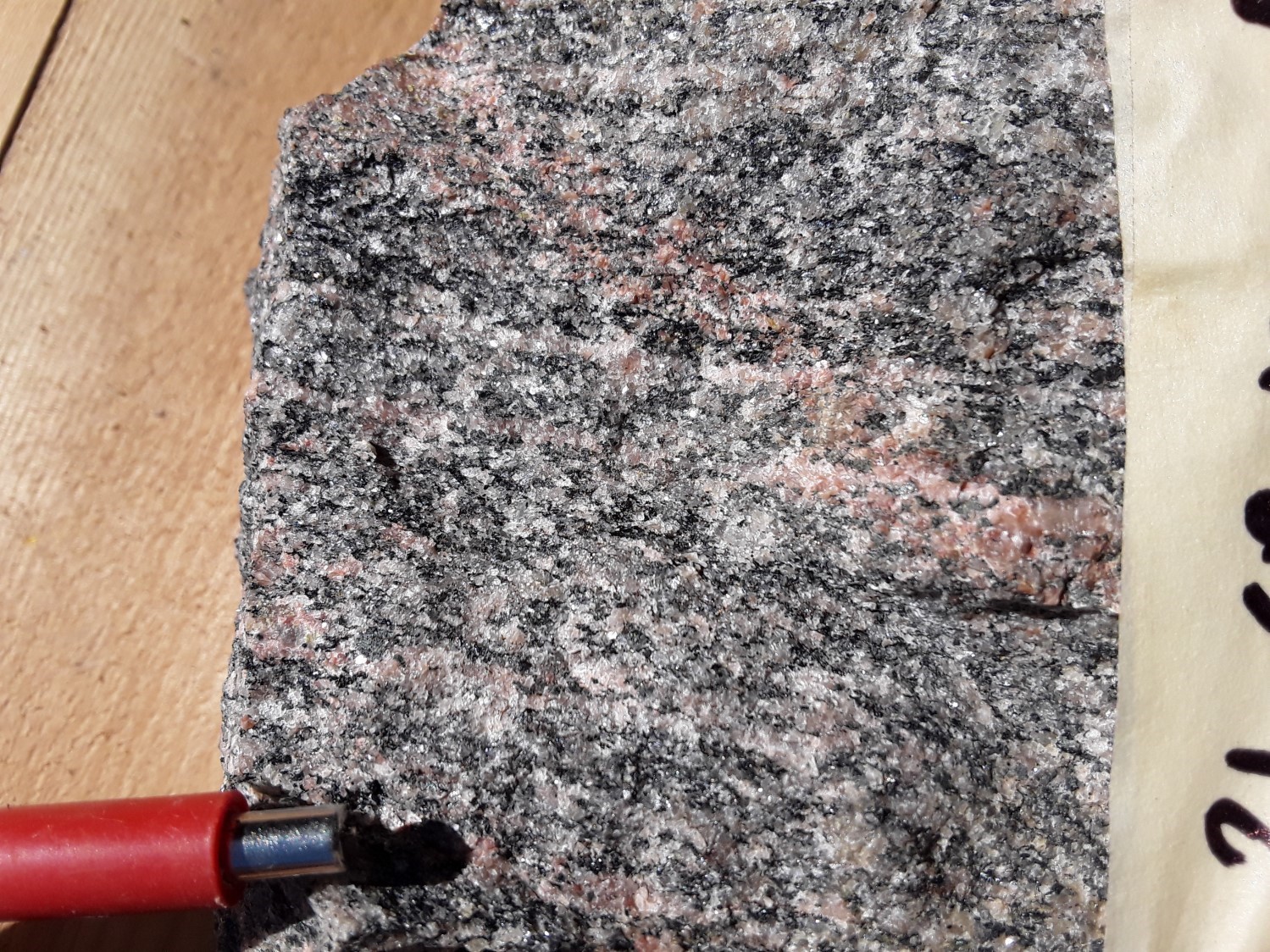
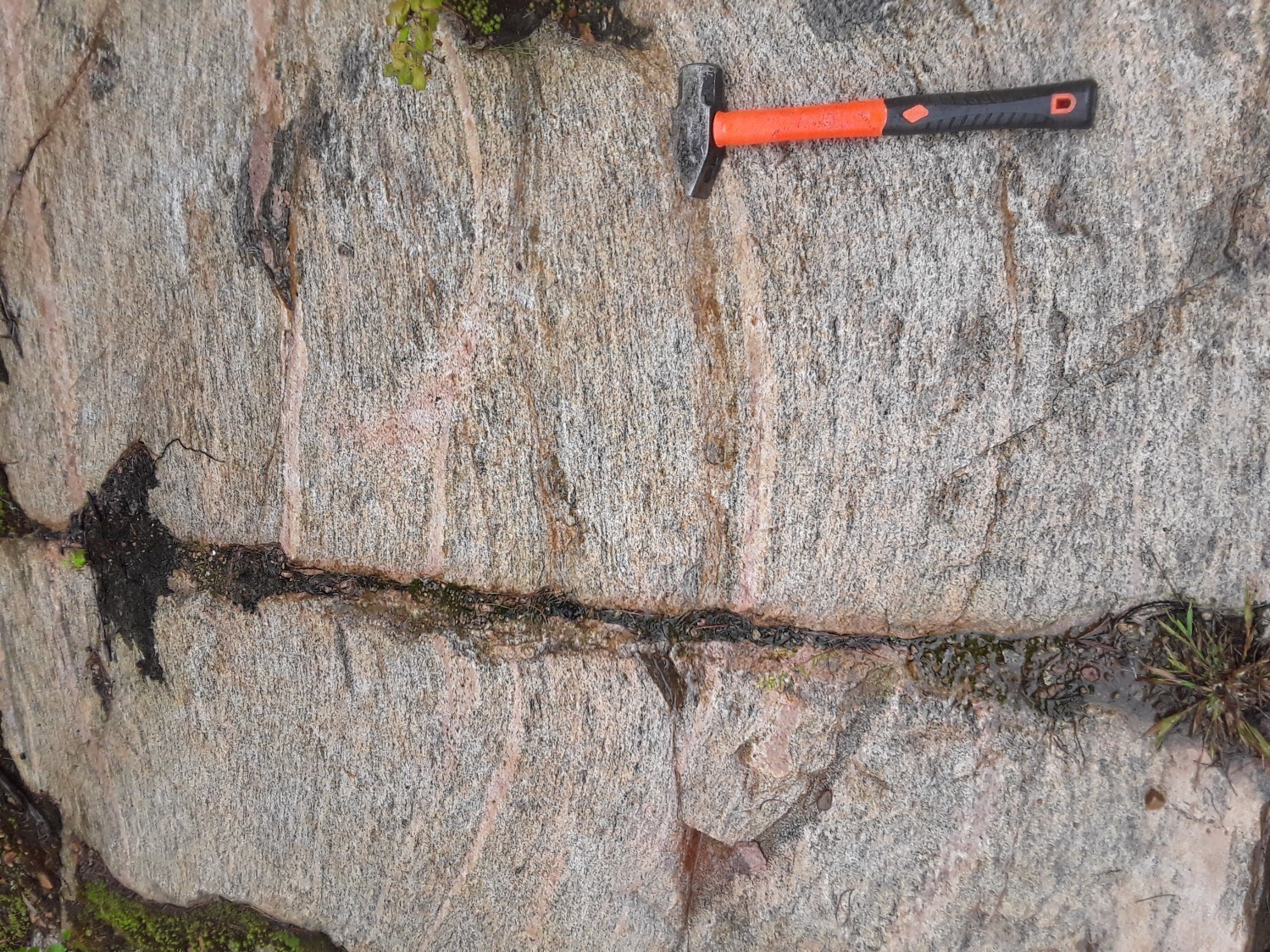
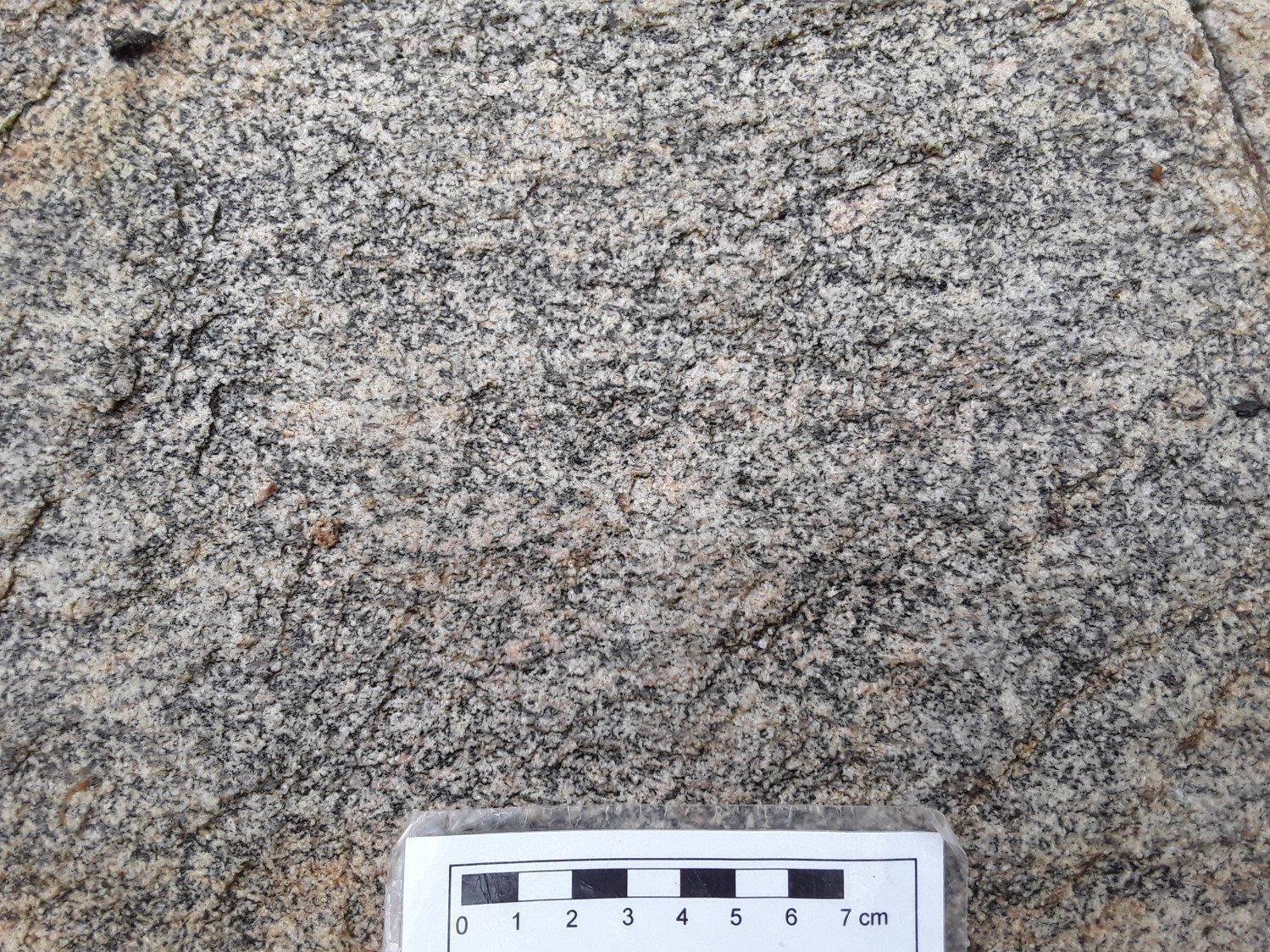 The first facies consists mainly of quartz monzonite and, to a lesser extent, monzodiorite and granodiorite. These rocks are light beige to beige, pinkish-beige or pinkish-grey in weathered surface and pinkish-beige to dark pinkish-beige or pinkish-grey in fresh surface. Quartz monzonite is highly foliated and fine to medium grained. It consists of 50% to 65% slightly damouritized plagioclase, up to 25% orthoclase, 1% to 15% microcline and ~10% quartz, locally going up to 25%. Feldspar and quartz are deformed and display undulatory extinction under the microscope, chessboard patterns and grain edge migration. Ferromagnesian minerals account for up to 20% of the composition, dominated by 15% fine to medium-sized hornblende. Other minerals include 2% clinopyroxene, 1% to 2% biotite, epidote reaching 5% in some samples, and 2% sulphides. Accessory minerals are apatite, zircon, allanite and titanite. Quartz monzonite contains an average of 10% small pinkish hololeucocratic quartz-feldspar bands, which are interpreted as a generation of small injections transposed into the foliation.
The first facies consists mainly of quartz monzonite and, to a lesser extent, monzodiorite and granodiorite. These rocks are light beige to beige, pinkish-beige or pinkish-grey in weathered surface and pinkish-beige to dark pinkish-beige or pinkish-grey in fresh surface. Quartz monzonite is highly foliated and fine to medium grained. It consists of 50% to 65% slightly damouritized plagioclase, up to 25% orthoclase, 1% to 15% microcline and ~10% quartz, locally going up to 25%. Feldspar and quartz are deformed and display undulatory extinction under the microscope, chessboard patterns and grain edge migration. Ferromagnesian minerals account for up to 20% of the composition, dominated by 15% fine to medium-sized hornblende. Other minerals include 2% clinopyroxene, 1% to 2% biotite, epidote reaching 5% in some samples, and 2% sulphides. Accessory minerals are apatite, zircon, allanite and titanite. Quartz monzonite contains an average of 10% small pinkish hololeucocratic quartz-feldspar bands, which are interpreted as a generation of small injections transposed into the foliation.
Alkali Feldspar Granite
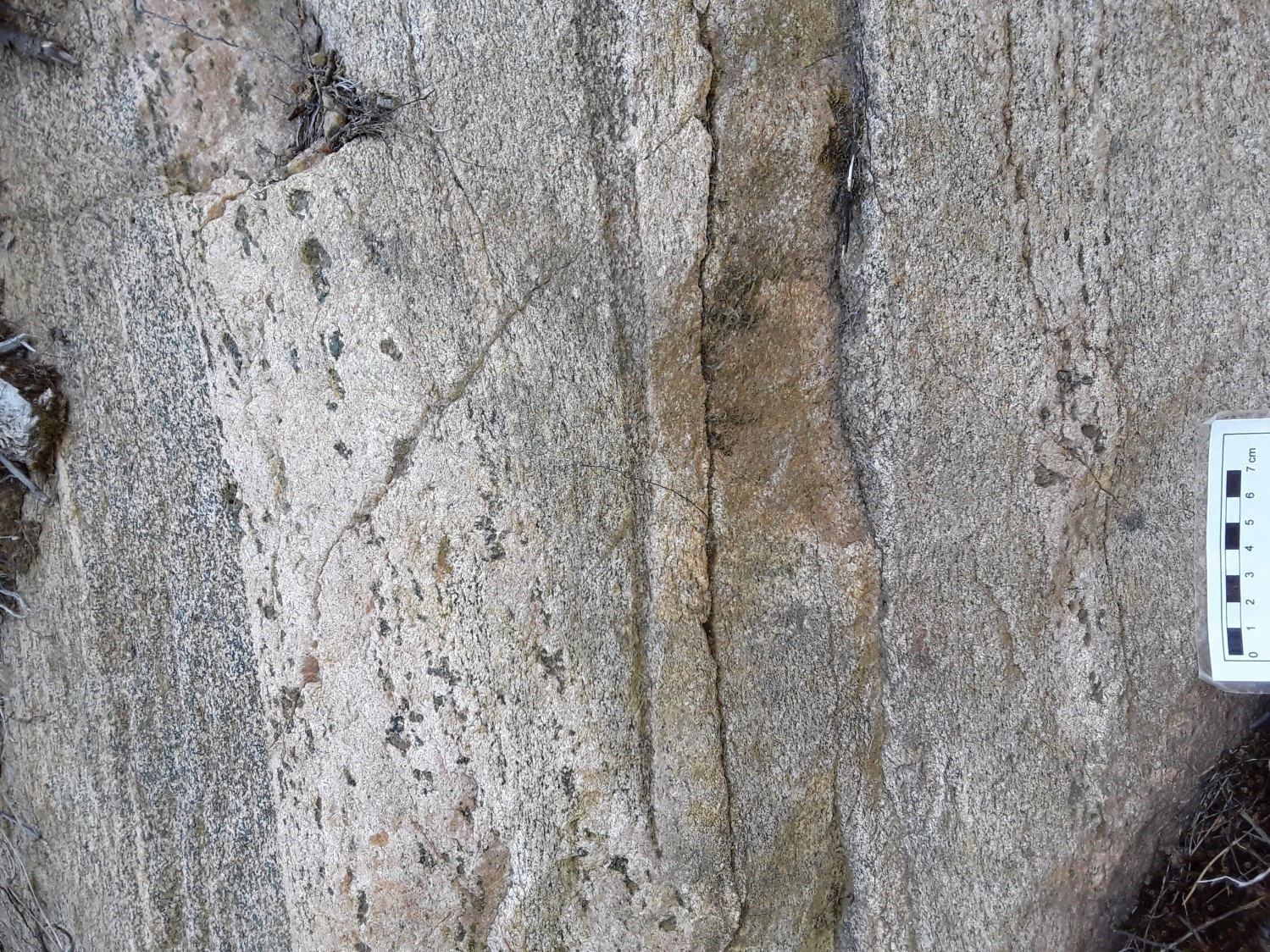
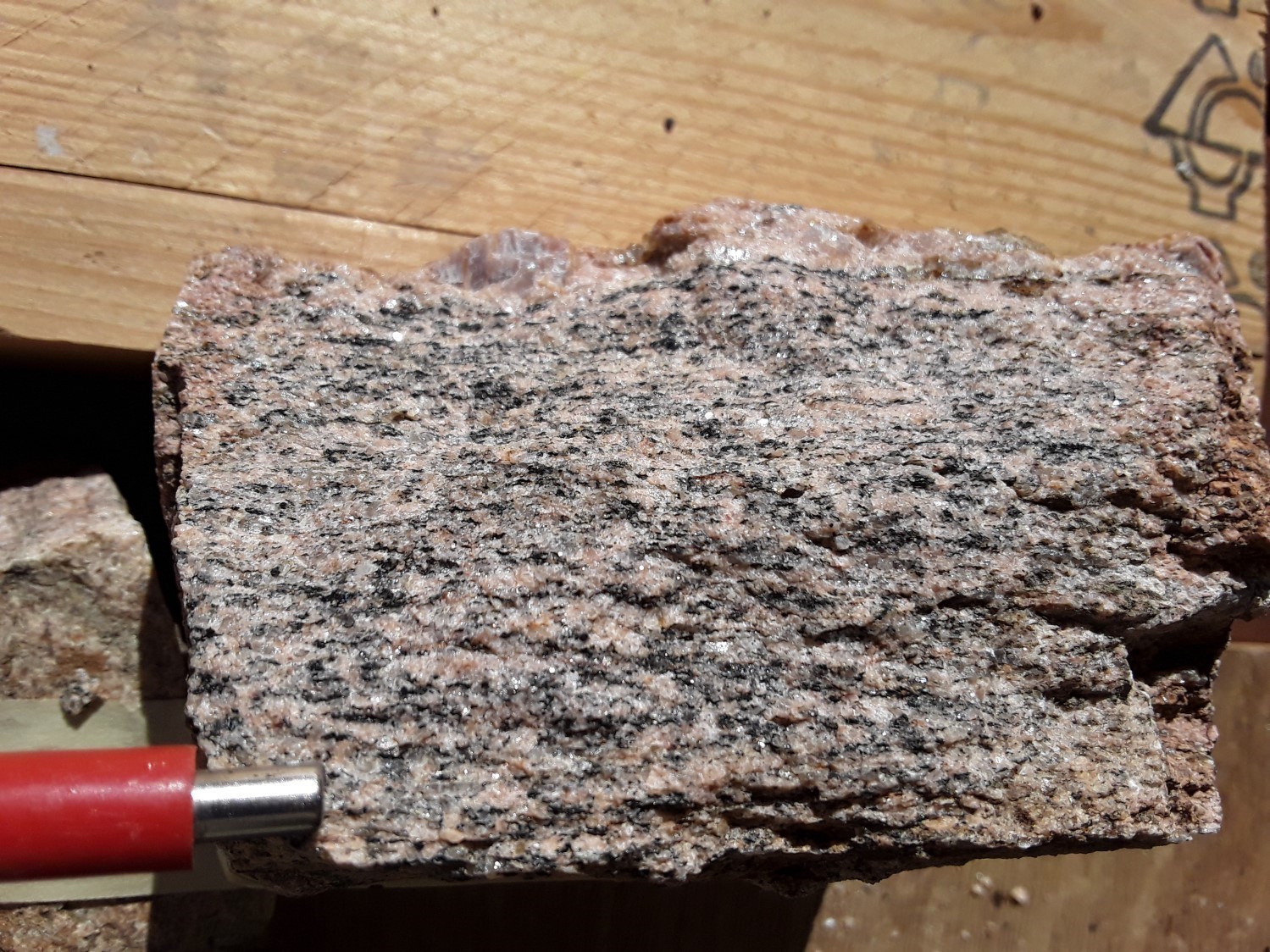
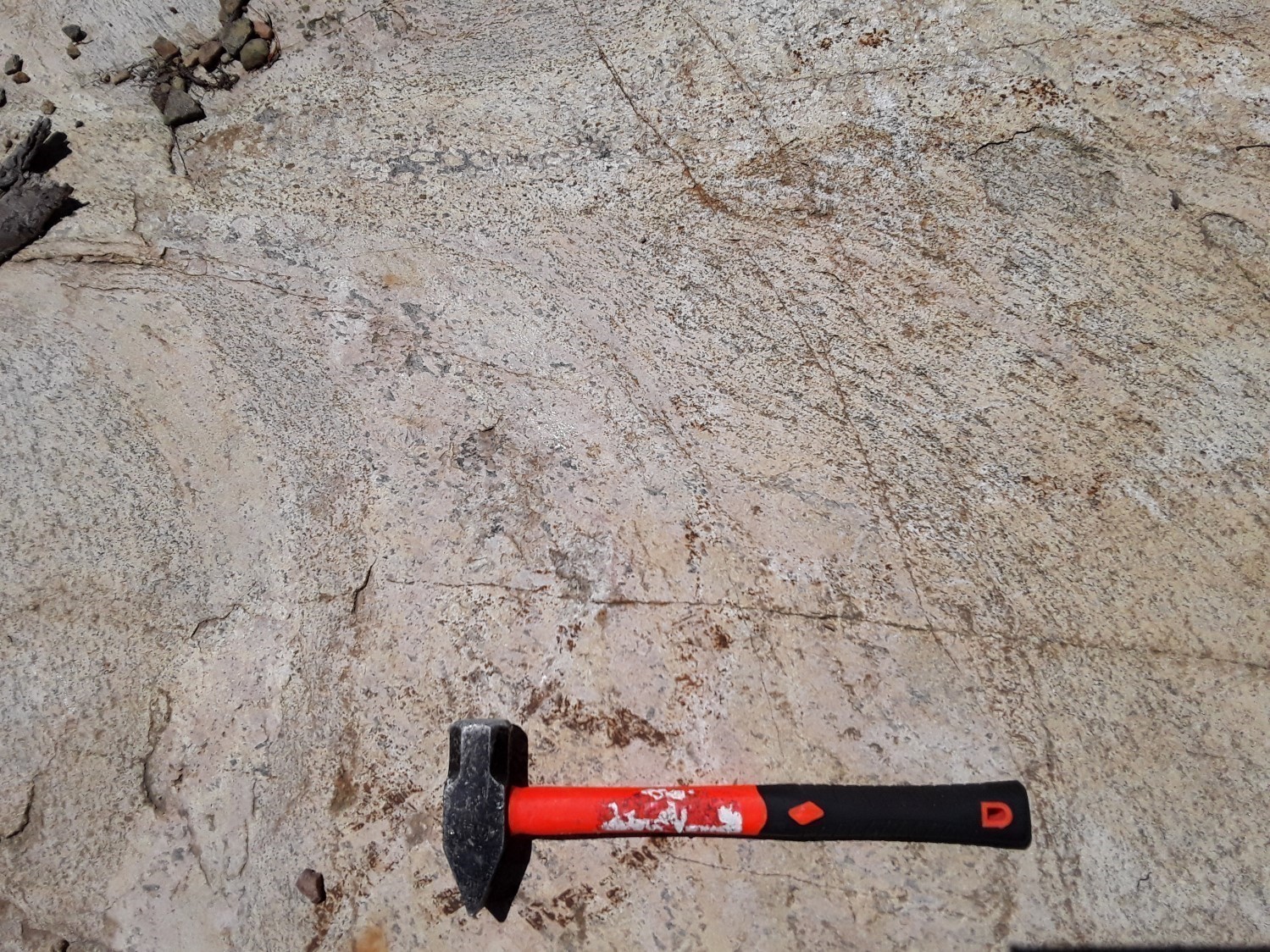
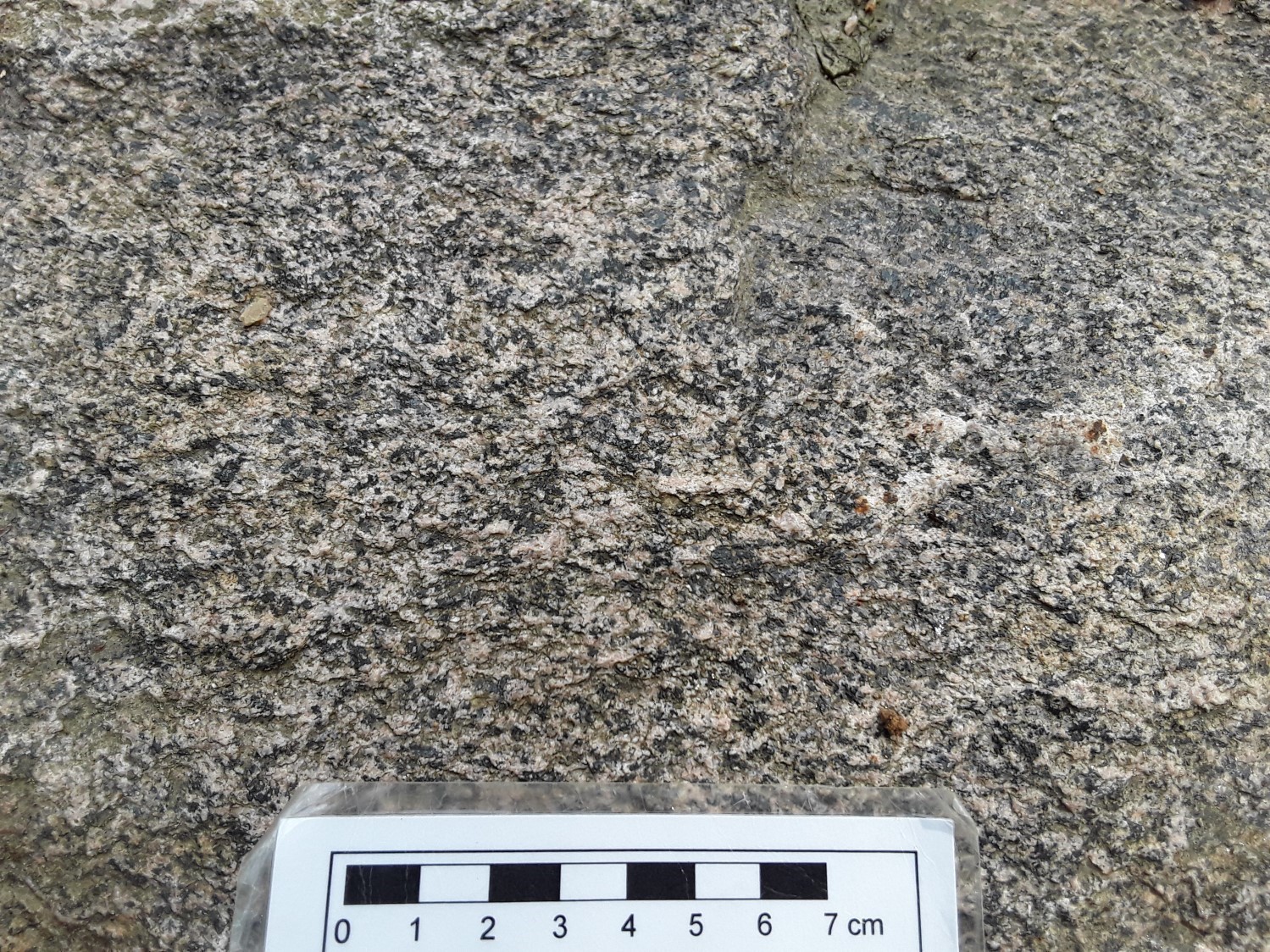 The alkali feldspar granite facies has a pink or light-beige alteration patina and variable colours in fresh surface, ranging from light to dark pink or grey to dark grey. The rocks are fine to medium grained and foliated to banded. They consist of 30% to 70% microcline and orthoclase, perthitic in some samples, as well as ~10% plagioclase and 20% to 30% quartz. K-feldspar is finer than plagioclase in every outcrop of this facies. Quartz and feldspar are recrystallized, and the rock doesn’t exhibit a well-developed granoblastic texture. Ferromagnesian minerals generally represent <10% of the volume of the rock, including 5% clinopyroxene, 1% to 2% biotite and 1% hornblende. Isolated, coronitic, coarse, brown minerals are locally present and interpreted as orthopyroxene surrounded by hornblende. Accessory minerals include epidote, opaque minerals, apatite, titanite and zircon. The alkali feldspar granite also contains small pinkish hololeucocratic quartz-feldspar bands transposed into the foliation. A small amount of small enclaves of mafic to intermediate composition and enclaves or klippes of orange calcitic marble are present locally. Concordant tabular layers of diorite-derived amphibolite make up a large pproprotion of some outcrops (e.g. 2021-CB-1116).
The alkali feldspar granite facies has a pink or light-beige alteration patina and variable colours in fresh surface, ranging from light to dark pink or grey to dark grey. The rocks are fine to medium grained and foliated to banded. They consist of 30% to 70% microcline and orthoclase, perthitic in some samples, as well as ~10% plagioclase and 20% to 30% quartz. K-feldspar is finer than plagioclase in every outcrop of this facies. Quartz and feldspar are recrystallized, and the rock doesn’t exhibit a well-developed granoblastic texture. Ferromagnesian minerals generally represent <10% of the volume of the rock, including 5% clinopyroxene, 1% to 2% biotite and 1% hornblende. Isolated, coronitic, coarse, brown minerals are locally present and interpreted as orthopyroxene surrounded by hornblende. Accessory minerals include epidote, opaque minerals, apatite, titanite and zircon. The alkali feldspar granite also contains small pinkish hololeucocratic quartz-feldspar bands transposed into the foliation. A small amount of small enclaves of mafic to intermediate composition and enclaves or klippes of orange calcitic marble are present locally. Concordant tabular layers of diorite-derived amphibolite make up a large pproprotion of some outcrops (e.g. 2021-CB-1116).
Coarse-grained Alkali Feldspar Granite Dykes
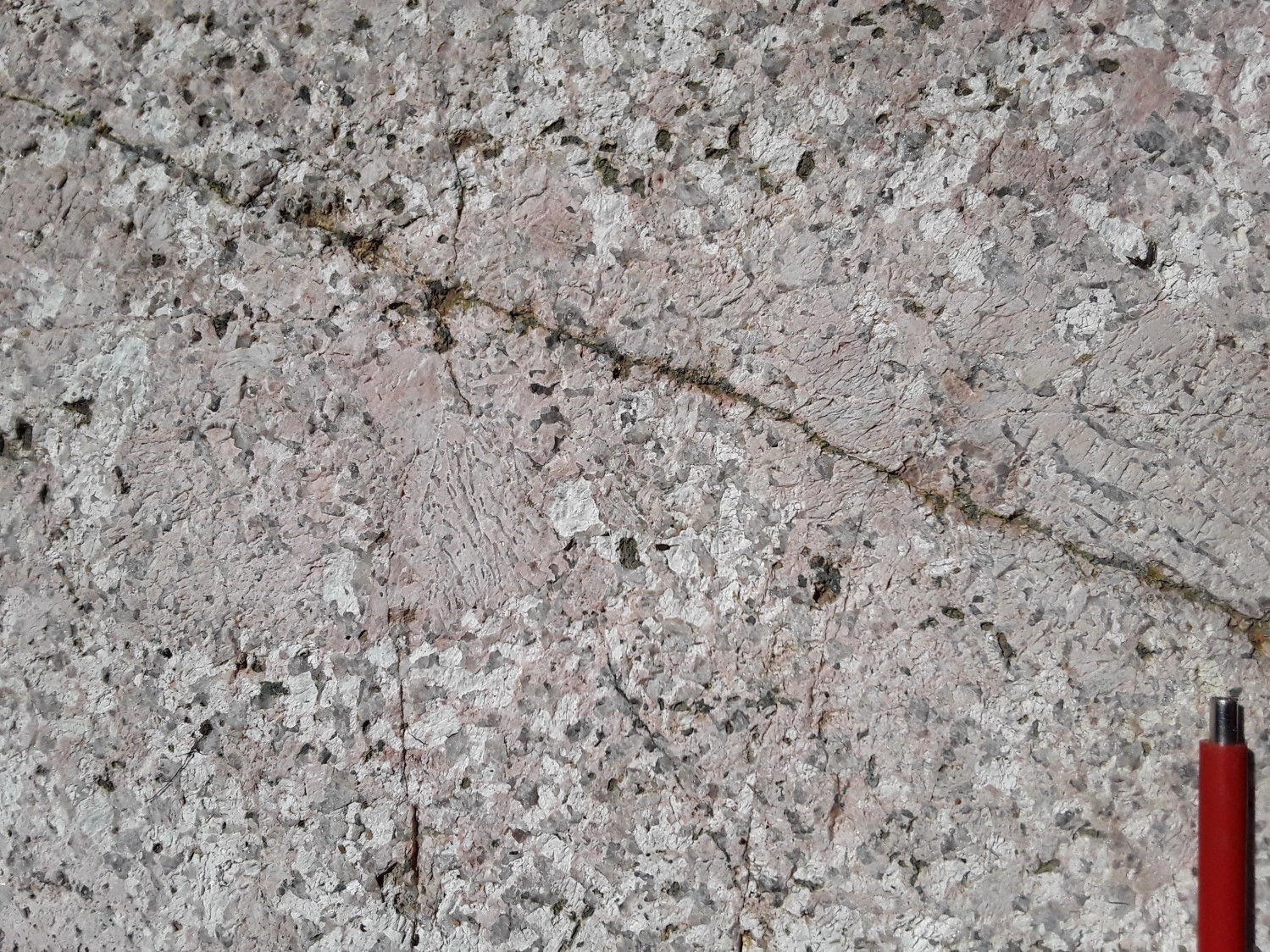
 The main lithologies are cut by 10% to 40% late potassic felsic intrusions forming isolated dykes up to 15 m thick or dense swarms of centimetric to metric veins. The rocks are hololeucocratic, predominantly light pink to pink with a pinkish-white alteration patina. They are mostly very heterogeneous in composition and grain size, ranging from medium to very coarse within a single sample. The rocks are mainly composed of quartz and K-feldspar, particularly as myrmekite and mosaics of granoblastic crystals. The contacts between the dykes and the host rock are sharp, non-planar and they cut the foliation in a secant to subconcordant manner.
The main lithologies are cut by 10% to 40% late potassic felsic intrusions forming isolated dykes up to 15 m thick or dense swarms of centimetric to metric veins. The rocks are hololeucocratic, predominantly light pink to pink with a pinkish-white alteration patina. They are mostly very heterogeneous in composition and grain size, ranging from medium to very coarse within a single sample. The rocks are mainly composed of quartz and K-feldspar, particularly as myrmekite and mosaics of granoblastic crystals. The contacts between the dykes and the host rock are sharp, non-planar and they cut the foliation in a secant to subconcordant manner.
Coarse-grained Gabbro Dykes

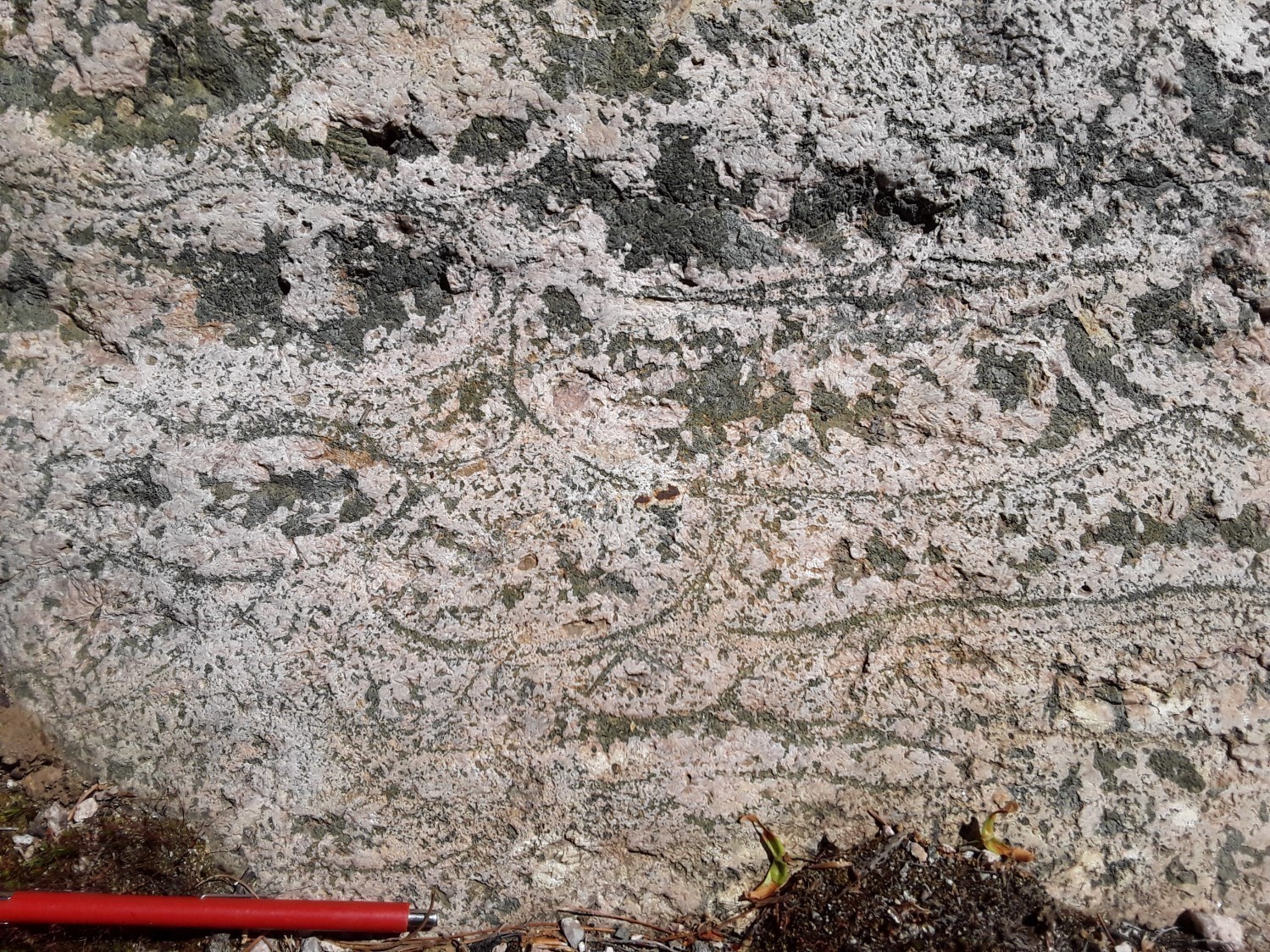
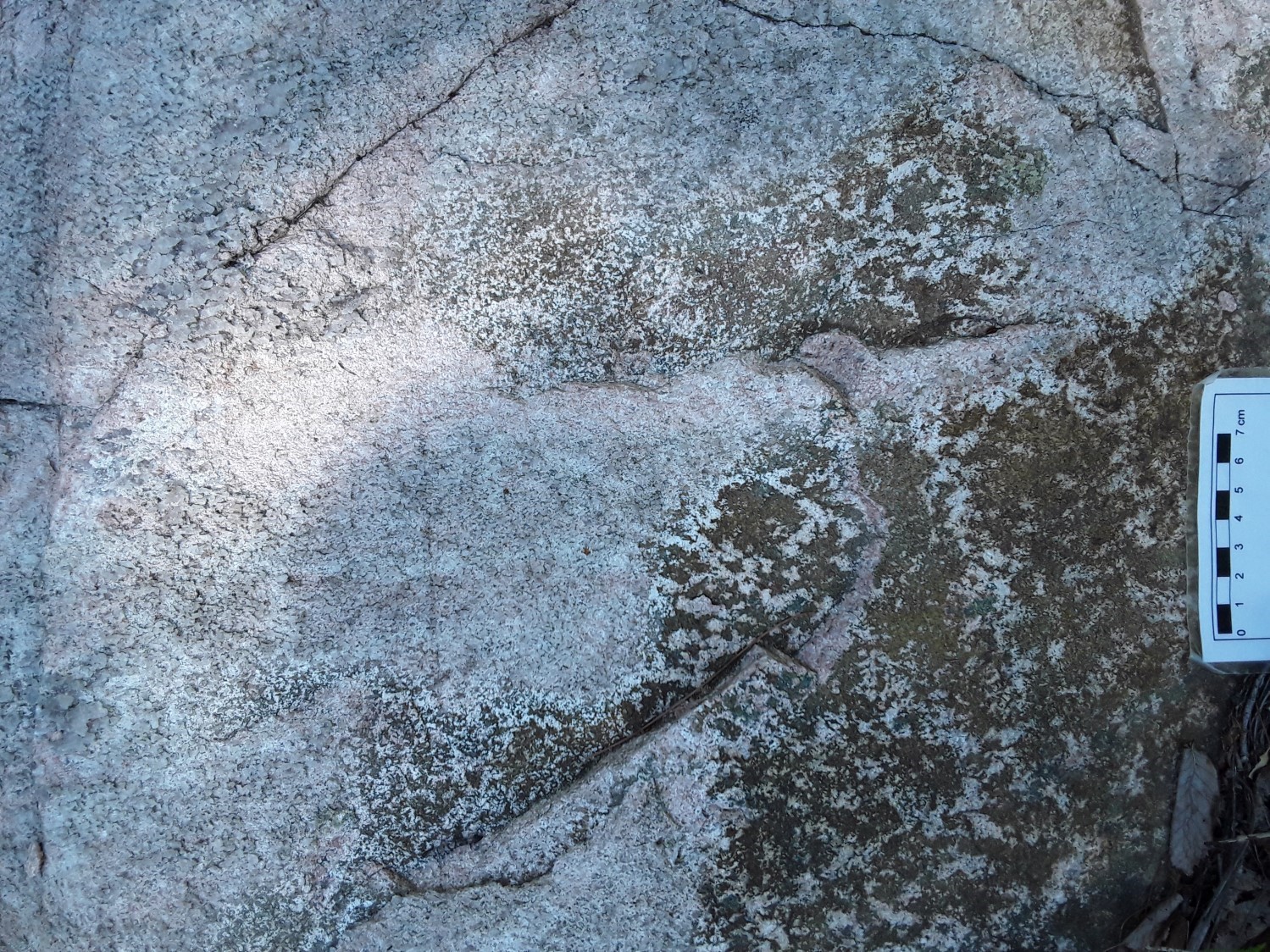 Late polyphase intrusions of intermediate to mafic mesocratic rocks cut through certain parts of the main facies. The dykes vary greatly in size, from a few centimetres to a maximum of 8 m thick. They are composed of equivalent proportions of fine to very coarse crystals of two varieties of clinopyroxenes and/or calcic amphiboles, including blackish-green or white to milky-light grey diopside. Some of these clear crystals may be nepheline. The dykes are characterized by centimetric coronite structures, including aureoles of fine green crystals around clusters of coarser white crystals. This particular structure is interpreted as being of magmatic origin. In some places, there is evidence of a coarse-grained phase cutting through a finer phase. Some locally deformed bodies are reminiscent of heterogranular enclaves highly enriched in pyroxenes, possibly representing enclaves of calc-silicate rock partially assimilated and metamorphosed by the main unit. The radiometric count obtained from these intrusions is generally low compared with that of the felsic and potassic intrusions described above. These rocks are characterized by a relatively high radiometric background of ~280 c/s, with a punctual maximum of 10,500 c/s (e.g. outcrop 2021-CB-1109).
Late polyphase intrusions of intermediate to mafic mesocratic rocks cut through certain parts of the main facies. The dykes vary greatly in size, from a few centimetres to a maximum of 8 m thick. They are composed of equivalent proportions of fine to very coarse crystals of two varieties of clinopyroxenes and/or calcic amphiboles, including blackish-green or white to milky-light grey diopside. Some of these clear crystals may be nepheline. The dykes are characterized by centimetric coronite structures, including aureoles of fine green crystals around clusters of coarser white crystals. This particular structure is interpreted as being of magmatic origin. In some places, there is evidence of a coarse-grained phase cutting through a finer phase. Some locally deformed bodies are reminiscent of heterogranular enclaves highly enriched in pyroxenes, possibly representing enclaves of calc-silicate rock partially assimilated and metamorphosed by the main unit. The radiometric count obtained from these intrusions is generally low compared with that of the felsic and potassic intrusions described above. These rocks are characterized by a relatively high radiometric background of ~280 c/s, with a punctual maximum of 10,500 c/s (e.g. outcrop 2021-CB-1109).
Thickness and Distribution
The Schwartz Intrusive Suite forms a single unit located NE of the Île-du-Grand-Calumet area (sheet 31F10). The total area of the unit is unknown and the extension of the suite continues into neighbouring sheets (sheets 31F09, 31F15 and 31F16). Based on low-resolution aeromagnetic surveys, the dimensions of the unit are roughly estimated at 6 km by 5.5 km for a surface area of 33 km².
Dating
A sample of homogeneous, foliated hornblende granodiorite from outcrop 2021-CB-1242 was analyzed for LA-ICP-MS dating. The zircon cores returned an age of 1254 ±20 Ma, interpreted as the crystallization age of the intrusion (Davis, 2023). An age of 1073 ±8 Ma was obtained from the overgrown crowns of the same crystals, which are possibly associated with the regional metamorphic episode of the Ottawa phase of the Grenvillian orogeny (Rivers, 1989).
| Unit | Sample Number | Isotopic System | Mineral | Crystallization Age (Ma) | (+) | (-) | Metamorphic Age (Ma) | (+) | (-) | Reference(s) |
| mPswz | 2021-CB-1242A | U-Pb | Zircon | 1254 | 20 | 20 | 1073 | 8 | 8 | Davis, 2023 |
Stratigraphic Relationship(s)
All outcrops of the Schwartz Intrusive Suite have been recorded in the NW of the Île-du Grand-Calumet area (sheet 31F10), forming the only mapped feature of this unit. Geochronological data indicate that it represents the oldest mapped intrusive unit in the area. It contains older layers of orange marble probably belonging to the Outaouais Supracrustal Sequence (mPoua1a) and dioritic amphibolite of unknown affiliation. The gabbro dykes and hololeucocratic felsic inttruions described earlier in this stratigraphic record have not been observed elsewhere than in the Schwartz Intrusive Suite, suggesting that the surrounding Litchfield Intrusive Suite chronologically cuts every lithologies of the Schwartz Intrusive Suite. However, gabbro dykes appear to cut the foliation of the main lithology, indicating a relatively young age of emplacement.
Paleontology
Does not apply.
References
Publications available through SIGÉOM Examine
BILODEAU, C., 2022. Géologie de la région de l’Île-du-Grand-Calumet, Province de Grenville, Outaouais, Québec, Canada. MERN; BG 2022-07, 1 plan.
DAVIS, D.W., 2023. Rapport sur les datations U-Pb de roches du Québec 2021-2022. MRNF; MB 2023-02
Other publications
RIVERS, T., MARTIGNOLE, J., GOWER, C.F., DAVIDSON, A., 1989. New tectonic divisions of The Grenville Province, southeast Canadian Shield. Tectonics; volume 8, pages 63-84. doi.org/10.1029/TC008i001p00063
Suggested Citation
Ministère des Ressources naturelles et des Forêts (MRNF). Schwartz Intrusive Suite. Quebec Stratigraphic Lexicon. https://gq.mines.gouv.qc.ca/lexique-stratigraphique/province-de-grenville/suite-intrusive-de-schwartz_en [accessed on Day Month Year].
Contributors
|
First publication |
Carl Bilodeau, P.Geo., M.Sc. carl.bilodeau@mrnf.gouv.qc.ca (redaction) Céline Dupuis, P.Geo., Ph.D. (coordination); Abdelali Moukhsil, P.Geo., Ph.D. (critical review); Simon Auclair, P.Geo., M.Sc. (editing); Catherine Tremblay (English version); André Tremblay (HTML editing). |

